If you read, you know well that most books look roughly like the image below–cover, preliminary pages, main text, and concluding parts. Do you really know, however, which is Parts of a Book? Today we break down an understanding of this basic outline in four important Parts of a Book: cover, front matter, text proper, and end matter. By the end you’ll be so versed in the vocabulary that you can analyze your book of your choice.
The Book Cover
The cover of any book first catches the eye of any reader and holds utmost importance in attracting one. A well-designed cover catches the attention of a potential reader by making it an important marketing product of a book. Its three major parts are :
Front Cover
The front cover usually contains a very appealing piece of artwork, the title of the book, and the name of the author. The key to sparking interest and creating the tone of the book is an eye-catching design that is in accordance with genre conventions.
Spine
The spine is the narrow edge of the book that shows the title, author, and publisher’s logo. This is what readers see when books are shelved, so it is an important part of book marketing and branding.
Back Cover
This would usually be the book’s back cover, with a blurb that usually carries a very short description to interest the readers. It may carry the author bio, book’s accolades and testimonials on it, giving further valuable insight into the book.
Front Matter

The front matter, or the preliminary pages, comprises everything found before the main text. The following may be of importance, as it will set in contextual and expectation for the reader; half-title page only contains the title of the book and thus takes place before the full title page. Usually, though, it becomes the very first page of a book that is printed and makes for an introductory opening introduction to the work; the title page
Title page; It contains the book’s title, author, and publisher, including an edition of the book. These help to identify the work while making it credible
Frontispiece
An illustration which appears on a page in front of the title page. It may be uncommon in the current period but can be added to the book to bring up some interesting first impressions with the reader.
Copyright page
On the other side of the title page, usually, it has the publication details of a book, which includes all the important things: the copyright notice, ISBN number, and the permissions of a book, giving legal status to the book.
Contents Page
It mentions the chapters of a book along with their respective page numbers to help a reader navigate or find out specific topics with ease.
This page is one in which the author gets a chance to dedicate this book to someone special as an additional personal touch and bonding between the author and his reader.
Foreword
A piece that is usually written by the author but not him is written to provide background or to establish credibility of the book. It often explains how work is important.
List of Abbreviations
This section explains any abbreviation or acronym that has appeared anywhere in the text as used in the technical writing work.
Preface
Written by the author, the preface introduces the book’s purpose and may discuss its creation and scope, providing readers with insight into the author’s intentions.
Main Text

Dip into the body and you’d find other elements that would orchestrate the plot and put the facts in place well enough:
Prologue
This is a lead-in to the main story. Hence, this would normally introduce some critical background information or events important to understanding the narrative.
Introduction
In non-fiction, the introduction sets up the reader for what awaits him, giving definitions and background that would grant clarity to understanding the subject matter.
Chapters
Chapters are the book’s divisions in which the narrative or subject is structured in such a way that readers move through the work logically.
Figures
Figures contain illustrations, diagrams, and photographs in order to present something visually, which often affords better understanding, especially for nonfiction.
Tables
Tables are used for the collection of data presented in a coherent manner whereby complicated information becomes easier reading and digestion for the reader.
Footnotes
Footnotes are those which provide ancillary information or references that appear at the bottom of the page, cited through superscript numbers in the body of the text, that illuminate the reading without marring the text.
Dinkus
A dinkus is a formative device used to divide a text or mark the changing of scenes within chapters to add a touch of aesthetics to the reading flow.
Epilogue
An epilogue brings closure to a story by going back into the lives of characters after the main story has ended, often projecting forward into the future and ending in satisfaction for readers.
End Matter
The back matter contains supplementary material that is presented after the body of the book and enhances the experience and knowledge of the reader:
Appendix
An appendix is a compilation of either detailed or supplementary information pertinent to the main text but too extensive to be included in the text, giving the reader an opportunity to understand topics more deeply.
Endnotes
Similar to footnotes, endnotes appear at the end of chapters or the book, where additional information or citations may be provided for readers looking for more information.
Reference List
This is a list of sources referenced directly within the book; therefore, this list proves academic integrity and also offers the reader access to source works for further information.
Bibliography
Bibliography encompasses all the sources that are consulted while writing. They may not necessarily be evident in the citations thus ensuring that the reader sees an overall view of research that has been carried out.
Glossary
Glossary is that portion of the book where technical terms used are explained. This helps the reader on their understanding and will even serve to demystify technical terms or phrases
In this section, authors thank those who contributed to the book’s creation, fostering a sense of community and gratitude for support received during the writing journey.
About the Author
This part offers biographical details about the author, enhancing reader connection and providing context for the author’s perspective and expertise.
Index
An index is an alphabetized list of topics and corresponding page numbers, facilitating easy navigation and helping readers locate specific content quickly.
Additional Elements
Finally, it’s worth noting some ongoing elements throughout the book:
Page Numbers
Page numbers, or “folios,” help readers track their place in the book, ensuring a seamless reading experience as they move from page to page.
Headers and Footers
These sections at the top and bottom of pages may include page numbers, the book title, or chapter headings, providing helpful reference points for readers.
Conclusion
Now that you’ve become masters of the knowledge of all the Parts of a Book, nothing can be made without having it analyzed by you in confidence. If you’re a reader seeking to increase your knowledge of literature, or if you are a budding author getting your manuscript ready, then these are pieces you should know well. If you’d like more insight into your writing or help with it, we’re here!
Call to Action
Enjoy this breakdown of book parts? Subscribe to our blog for more writing and publishing tips. And don’t forget to download our handy PDF guide for quick reference!








